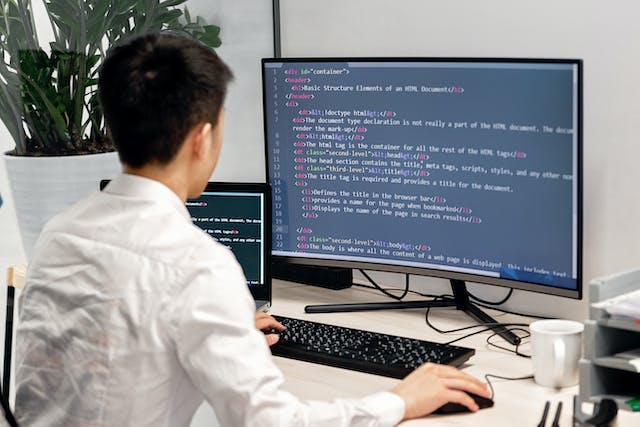PHP Developer Interview Questions with Answers

For hiring managers and job seekers, PHP Developer Interview Questions are crucial for finding candidates who excel both technically and practically. Therefore, we’ve compiled a list of targeted questions with clear, straightforward answers. These questions address everything from basic syntax and functions to complex problem-solving scenarios, allowing you to effectively assess potential candidates’ skills and expertise.
1. What are the main error types in PHP, and how do they differ?
Answer: The main error types in PHP are notices, warnings, and fatal errors. Notices are minor issues that do not stop the script from running. However, warnings are more serious but still allow the script to run. On the other hand, fatal errors cause the script to stop execution.
2. Explain the use of sessions in PHP.
Answer: PHP uses sessions to store information about a user across multiple pages. Consequently, this feature helps maintain data during subsequent visits and is useful for building functions like user login systems.
3. What is the difference between GET and POST methods in form submission?
Answer: GET appends data to the URL and is visible, making it less secure and limited in data length. POST sends data as part of the request body, offering more security and capacity for larger data volumes.
4. How can you prevent SQL injection in PHP?
Answer: Use prepared statements with PDO (PHP Data Objects) or MySQLi to prevent SQL injection. These methods automatically handle escaping special characters, securing your database queries.
5. Describe what a PDO is in PHP.
Answer: PDO stands for PHP Data Objects, a database access layer providing a uniform method of access to multiple databases.
6. What does the include statement do in PHP?
Answer: The include statement copies the content of a specified file into the file that uses it. As a result, this statement inserts one PHP file’s contents into another before the server executes it.
7. What are PHP Magic Methods?
Answer: PHP magic methods are special functions that have specific names starting with double underscores (__) like __construct(), __destruct(), __call(), etc. They are triggered in response to particular PHP events.
8. What is the purpose of the __construct() method?
Answer: The __construct() method is a magic method that automatically initializes an object when it is created, often used to set up initial object properties.
9. How do you declare a constant in PHP?
Answer: Constants in PHP are defined using the define() function or the const keyword. Once set, their values cannot be changed during script execution.
10. What are traits in PHP?
Answer: Traits allow for code reuse in PHP. You can insert methods from traits into a class, similar to how you use classes.
11. Explain namespacing in PHP and its benefits.
Answer: PHP uses namespaces to encapsulate items such as classes, interfaces, functions, and constants. This approach helps prevent name collisions between code from different libraries or applications.
12. What is the purpose of the final keyword in PHP?
Answer: The final keyword prevents child classes from overriding a method by prefixing the definition with final. If the class itself is being defined final, then it cannot be extended.
13. What does === operator do in PHP?
Answer: The === operator, also known as the identity operator, checks if the value and the type of two variables are identical.
14. How can you increase the execution time of a PHP script?
Answer: The execution time can be increased by changing the max_execution_time directive in the php.ini file, or by calling set_time_limit() function in the script.
15. What is the difference between echo and print in PHP?
Answer: Both echo and print are used to output data to the screen. echo has no return value, is slightly faster and can take multiple parameters, while print has a return value of 1 and can only take one argument.
16. How do you check if a variable is an array in PHP?
Answer: Use the is_array() function to check whether a variable is an array.
17. What is the difference between unset() and unlink()?
Answer: unset() destroys a given variable, while unlink() deletes a file we are referring to from the file system.
18. How do you start and destroy a session in PHP?
Answer: A session is started with the session_start() function and destroyed with session_destroy() function.
19. How to Use Interfaces in PHP.
Answer: Interfaces in PHP define public methods that a class must implement without implementing the methods. They ensure a class adheres to a particular contract.
20. Explain inheritance in PHP.
Answer: Inheritance is a principle where a new class (child class) is based on an existing class (parent class), inheriting all public and protected properties and methods.
21. How can you prevent Cross-site Scripting (XSS) in PHP?
Answer: Prevent XSS by sanitizing user input, especially data that gets output to the browser. This includes stripping tags, encoding, or validating inputs.
22. What is the implode() function in PHP?
Answer: The implode() function joins elements of an array into a single string.
23. Describe the use of header() function in PHP.
Answer: The header() function sends a raw HTTP header to a client. It’s often used to redirect users to another page.
24. What are constructors and destructors in PHP?
Answer: Constructors automatically run when you create an object, while destructors run when you destroy an object or when the script ends.
25. Explain the difference between array_merge() and array_combine().
Answer: array_merge() merges one or more arrays into one array, while array_combine() creates a new array, using one array for keys and another for its values.
26. How does foreach loop work in PHP?
Answer: The foreach loop iterates over elements of an array or properties of an object.
27. What are anonymous functions in PHP?
Answer: Anonymous functions, also known as closures, allow the creation of functions which have no specified name. They are most useful as the value of callback parameters.
28. What is strtotime() used for in PHP?
Answer: strtotime() is used to convert an English textual datetime description into a Unix timestamp.
29. How can you handle exceptions in PHP?
Answer: Exceptions in PHP can be handled using the try, catch, and finally statements. Code that may throw an exception is put inside the try block and the exception is caught in the catch block.
30. Explain the difference between include, include_once, require and require_once.
Answer: include and require are used to insert the contents of one PHP file into another PHP file; include does not stop the script execution on error, while require does. Adding _once prevents files from being included or required more than once.
Common Technologies Used by PHP Developers

PHP developers need a range of skills and expertise to handle various aspects of web development efficiently. Key areas of expertise commonly required include:
- MySQL: A popular relational database management system often used with PHP for database functionality.
- Apache: A widely used web server software that PHP developers commonly deploy alongside PHP to serve web pages.
- Laravel: A modern PHP framework for web applications that provides a structured and standardized way to build robust web applications.
- Symfony: Another PHP framework that provides components and tools to developers for building complex web applications more efficiently.
- Composer: A dependency management tool for PHP, allowing developers to manage libraries that their projects depend on.
- JavaScript: Often used alongside PHP to enhance the interactivity of web pages. Libraries like jQuery are commonly used.
- HTML/CSS: Essential for web development, used to structure content and style it on the web pages that PHP serves.
- Git: Version control system commonly used for managing PHP project code, especially in team environments.
- Docker: Used to containerize PHP applications, ensuring they run consistently across different computing environments.
- RESTful APIs: PHP often develops RESTful APIs due to its simplicity and built-in web capabilities.
Need to Hire PHP Developers?

If you’re looking to expand your team with skilled PHP developers, Tier2Tek Staffing can connect you with top talent efficiently and effectively. Our expertise ensures that we understand your specific requirements and help you find the perfect match.
